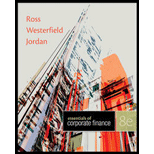
Essentials of Corporate Finance
8th Edition
ISBN: 9780078034756
Author: Stephen A. Ross, Randolph W. Westerfield, Bradford D. Jordan
Publisher: MCGRAW-HILL HIGHER EDUCATION
expand_more
expand_more
format_list_bulleted
Question
Chapter 4, Problem 4.2BCQ
Summary Introduction
To discuss: The opposite of discounting the cash flows to be received in the future back to the present.
Introduction:
The value of dollar at present will not be the same as the value of dollar earned in the future. The value of money deteriorates as the years pass by. Hence, the
The present value of money helps in calculating the present value of future cash receipts. The future value of money refers to the amount of dollars that an investment grows over a definite period at a particular rate of interest rate.
Expert Solution & Answer
Want to see the full answer?
Check out a sample textbook solution
Students have asked these similar questions
Define the time value of money (TVM). How does TVM influence decision-making in capital budgeting? Explanation.
What is the relationship between risk and return in finance, and how is this reflected in the Capital Asset Pricing Model (CAPM)?
3. Explain the concept of compounding. How does compounding impact the future value of an investment? Need help!
Chapter 4 Solutions
Essentials of Corporate Finance
Ch. 4 - Prob. 4.1ACQCh. 4 - Prob. 4.1BCQCh. 4 - In general, what is the future value of 1 invested...Ch. 4 - What do we mean by the present value of an...Ch. 4 - Prob. 4.2BCQCh. 4 - Prob. 4.2CCQCh. 4 - Prob. 4.2DCQCh. 4 - What is the basic present value equation?Ch. 4 - Prob. 4.3BCQCh. 4 - Prob. 4.1C
Ch. 4 - Prob. 4.2CCh. 4 - Prob. 4.3CCh. 4 - Prob. 1CTCRCh. 4 - Prob. 2CTCRCh. 4 - Prob. 3CTCRCh. 4 - Prob. 4CTCRCh. 4 - Prob. 5CTCRCh. 4 - Prob. 6CTCRCh. 4 - Prob. 7CTCRCh. 4 - Prob. 8CTCRCh. 4 - Prob. 9CTCRCh. 4 - Prob. 10CTCRCh. 4 - Prob. 1QPCh. 4 - Prob. 2QPCh. 4 - Prob. 3QPCh. 4 - Prob. 4QPCh. 4 - Prob. 5QPCh. 4 - Prob. 6QPCh. 4 - Prob. 7QPCh. 4 - Prob. 8QPCh. 4 - Prob. 9QPCh. 4 - Prob. 10QPCh. 4 - Prob. 11QPCh. 4 - Prob. 12QPCh. 4 - Prob. 13QPCh. 4 - Prob. 14QPCh. 4 - Prob. 15QPCh. 4 - Prob. 16QPCh. 4 - Prob. 17QPCh. 4 - Prob. 18QPCh. 4 - Prob. 19QPCh. 4 - Prob. 20QPCh. 4 - Prob. 21QPCh. 4 - Prob. 22QPCh. 4 - Prob. 23QPCh. 4 - Prob. 24QPCh. 4 - Prob. 25QPCh. 4 - Calculating Future Values. You have 20,000 you...
Knowledge Booster
Similar questions
- 3. Explain the concept of compounding. How does compounding impact the future value of an investment?arrow_forwardWhat is the difference between a stock and a bond, and how do they function as investment options? Need help now !arrow_forwardWhat is the difference between a stock and a bond, and how do they function as investment options? Rxplarrow_forward
- What does the internal rate of return (IRR) tell you about a potential investment? Rxarrow_forwardWhy is the Weighted Average Cost of Capital (WACC) important for a company's decision-making? Explanation.arrow_forwardWhy is the Weighted Average Cost of Capital (WACC) important for a company's decision-making?arrow_forward
- How does compounding differ from simple interest, and why does compounding result in higher returns over time?arrow_forwardWhat is the relationship between bond prices and interest rates, and why does this relationship exist? Explain.arrow_forwardWhat is the relationship between bond prices and interest rates, and why does this relationship exist?arrow_forward
- How do you calculate the payback period of an investment, and what are its limitations as a decision-making tool?arrow_forwardWhat are the main components of a company's capital structure, and how does each affect the company's overall risk and return?arrow_forwardWhat does the internal rate of return (IRR) tell you about a potential investment?arrow_forward
arrow_back_ios
SEE MORE QUESTIONS
arrow_forward_ios
Recommended textbooks for you
- Principles of Accounting Volume 2AccountingISBN:9781947172609Author:OpenStaxPublisher:OpenStax College



Principles of Accounting Volume 2
Accounting
ISBN:9781947172609
Author:OpenStax
Publisher:OpenStax College